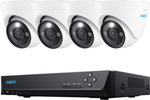Description:
Note: This bundle consists of 1-Pack RLN8-410 and 4-Pack RLC-1224A.
Original price: $1179.99
Now: $802.39
Savings: 32%
Get it here: Reolink RLK8-1200D4-A
Key Features
* 12MP Ultra HD
* Person/Vehicle/Pet Detection
* Color Night Vision
* Power over Ethernet
* 8-Channel NVR
* 2-Way Audio
* 2-Year Warranty
* Without Subscription
* Recording: 1)Micro SD Card, not included; 2)FTP; 3)Reolink NVR, included.




4x 12MP cameras will fill up 2TB in 7 days with continuous recording. However, the Reolink cameras have a pretty bulletproof motion detection system so leaving it on motion recording will be sufficient.